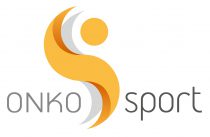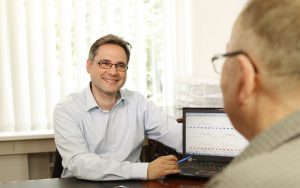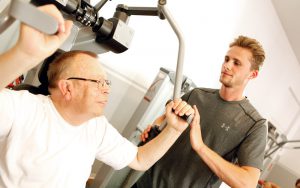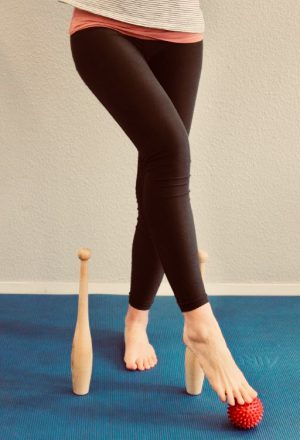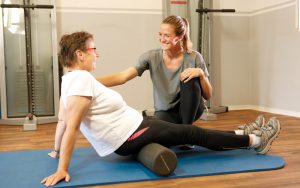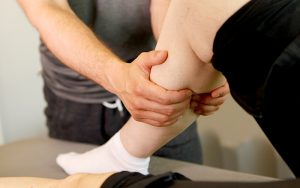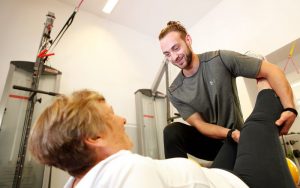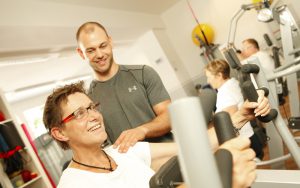Welcome
The team at the Bonn/Rhein-Sieg Onko-Sport Centre would like to warmly welcome you.
Here with us, the focus is always on the patient!
Sport and cancer?
Up until a few years ago, cancer patients were warned against any kind of physical exertion. Since then however, scientific studies have shown that physical activity has many positive effects within the framework of oncological therapies. Exercise is now seen as an effective and supportive therapeutic measure in cancer cases.
Physical movement leads to increased tolerance of the medical-oncological therapy (operation, chemotherapy, radiotherapy). An increase in physical fitness can decrease and/or prevent side effects such as nausea, vomiting, fatigue syndrome (illness-induced tiredness), decrease in muscle-power and bone density, pain, lack of drive and weight loss, which in turn has positive effects on the patient’s quality of life and daily performance. In all respects, patients suffering from many different illnesses benefit from being physically active or engaging in sports activity.
What is Onko-Sport?
Onko-Sport is a training concept that is supervised by a doctor and a physiotherapist, and was developed especially for cancer patients. It provides cancer patients with a tried-and-tested training concept that includes movement-based therapeutic exercises for maintaining and stabilising power, stamina, mobility and balance.
Read more...
Before you start the training, your doctor will first assess your suitability for participating in the Onko-Sport programme. Your training therapist will then compile your training plan based on an existing performance diagnostic. Training plans are always tailored to the patient’s specific needs, taking current health and physical capability into account. Our training programme has been created in a flexible manner, which means it can be easily adapted to your training progress and your condition on any given day. The treatment concept is based on the current recommendations from the German Academy for Sport in Cologne, and the latest research results in the field of cancer and sport. This means the specially designed concept is suitable for patients before, during and after cancer treatment.
Training Goals
STRENGTHENING THE BODY’S DEFENCES AND IMMUNE SYSTEM
REDUCING FUNCTIONAL LIMITATIONS OF THE MUSCULOSKELETAL SYSTEM
IMPROVING THE PHYSICAL CONDITION AND FEELING OF SELF-WORTH
ESTABLISHING SOCIAL CONTACTS AND PSYCHOSOCIAL STRENGTHENING
IMPROVING QUALITY OF LIFE
REDUCING FUNCTIONAL LIMITATIONS OF THE MUSCULOSKELETAL SYSTEM
STRENGTHENING THE BODY’S DEFENCES AND IMMUNE SYSTEM
FUN IN MOVEMENT
FACILITATING REENTRY INTO DAILY LIFE AND YOUR CAREER
IMPROVING GENERAL WELLBEING
Who are we?
We at the Bonn/Rhein-Sieg Onko-Sport Centre are a medical cooperation of the

Centre for Physical and Rehabilitative Medicine (ZPRM)
Dr. med. Evren Atabas
www.zprm-bonn.de

TrigenumPhysio
Praxis for Physiotherapie
www.trigenumphysio.de
Mission and Goals
Being diagnosed with cancer is completely unexpected for most people. As a result, living conditions and health often change dramatically and the usual daily routine is regularly thrown completely off kilter. We, the medical and therapeutic team here at the Bonn/Rhein-Sieg Onko-Sport Centre, have made it our mission to act upon this in a compensatory and rehabilitating manner.
Read more...
We want to support affected patients on their way back to a self-determined life and, in doing so, help them to meet the required standards for day-to-day living. Taking physical and psychological stability through sport as a starting point, we want to help patients regain their lust for life and quality of life. The primary goals of our work are to treat the side effects of cancer therapy, improve physical and psychological well-being and facilitate the best possible reentry into day-to-day life, work and society. The Onko-Sport Centre has set itself the goal of providing and guaranteeing oncology patients in the Bonn/Rhein-Sieg area with ongoing, high-quality, sport-based support before, during and after their medical treatment. What’s more, the patients should be motivated to engage in further physical activity outside of the Onko-Sport Centre in order to speed up their recovery. We aim to achieve this goal by working with an interdisciplinary network of professionals from the fields of medicine, physiotherapy and care work, who provide patients with high-quality and qualified support on all levels.
Therapy offers
Cost transfer
Our services are available to all patients of statutory insurance schemes, private patients and BG patients.
